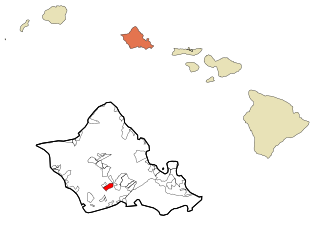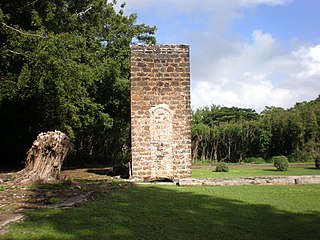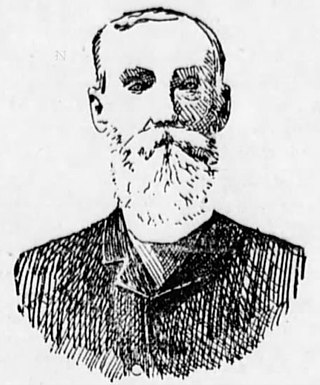Related Research Articles

Waipahu is a former sugarcane plantation town and now census-designated place (CDP) located in the ʻEwa District on the island of Oʻahu in the City & County of Honolulu, Hawaiʻi, United States. As of the 2020 census, the CDP population was 43,485. The U.S. postal code for Waipahu is 96797.

Walter Francis Dillingham called the Baron of Hawaii Industry, was an industrialist and businessman from Honolulu, Hawaii. He gained favors from Hawaii politicians to develop urban Honolulu.

Puerto Rican migration to Hawaii began when Puerto Rico's sugar industry was devastated by two hurricanes in 1899. The devastation caused a worldwide shortage in sugar and a huge demand for the product from Hawaii. Consequently, Hawaiian sugarcane plantation owners began to recruit the jobless, but experienced, laborers in Puerto Rico.

The Ilocanos, Ilokanos, or Iloko people are the third largest Filipino ethnolinguistic group and mostly reside within the Ilocos Region, in the northwestern seaboard of Luzon, Philippines. The native language of the Ilocano people is the Ilocano language.
Pablo Manlapit was a migrant laborer, lawyer, labor organizer, and activist in Hawaii, California, and the Philippines.
Founded in 1895, the Hawaiian Sugar Planters' Association (HSPA) was an unincorporated, voluntary organization of sugarcane plantation owners in the Hawaiian Islands. Its objective was to promote the mutual benefits of its members and the development of the sugar industry in the islands. It conducted scientific studies and gathered accurate records about the sugar industry. The HSPA practiced paternalistic management. Plantation owners introduced welfare programs, sometimes out of concern for the workers, but often designed to suit their economic ends. Threats, coercion, and "divide and rule" tactics were employed, particularly to keep the plantation workers ethnically segregated.
The Hanapēpē Massacre occurred on September 9, 1924, when an interethnic dispute amongst Filipino strike organizers in Hanapēpē, Kaua'i resulted in a violent exchange between local police officers and Filipinos. The conflict began when two Ilocano youth, allegedly breaking the Filipino-led labor strike, were detained and harassed by a group of Visayans at the Hanapepe strike camp. When the local police were called to settle the dispute, they arrived with a group of heavily armed special deputies. Upon arrival, the officers issued warrants of arrest for the two detained Illocanos, causing the collection of Filipino strikers to rally in opposition. Despite previously ridiculing the two Ilocanos, the remaining Filipinos armed themselves and demanded the boys be released. A violent exchange ensued wherein sixteen Filipino laborers and four police officers were left dead.

Sugarcane was introduced to Hawaiʻi by its first inhabitants in approximately 600 AD and was observed by Captain Cook upon arrival in the islands in 1778. Sugar quickly turned into a big business and generated rapid population growth in the islands with 337,000 people immigrating over the span of a century. The sugar grown and processed in Hawaiʻi was shipped primarily to the United States and, in smaller quantities, globally. Sugarcane and pineapple plantations were the largest employers in Hawaiʻi. Today both are gone, production having moved to other countries.

The Old Sugar Mill of Kōloa was part of the first commercially successful sugarcane plantation in Hawaiʻi, which was founded in Kōloa on the island of Kauai in 1835 by Ladd & Company. This was the beginning of what would become Hawaii's largest industry. The building was designated a National Historic Landmark on December 29, 1962. A stone chimney and foundations remain from 1840.
Manuel Olivieri Sánchez was a court interpreter and civil rights activist who led the legal battle which recognized U.S. citizenship for Puerto Ricans living in Hawaii.

The Hawaii Democratic Revolution of 1954 is a popular term for the territorial elections of 1954 in which the long dominance of the Hawaii Republican Party in the legislature came to an abrupt end, replaced by the Democratic Party of Hawaii which has remained dominant since. The shift was preceded by general strikes, protests, and other acts of civil disobedience that took place in the Hawaiian Archipelago. The strikes by the Isles' labor workers demanded similar pay and benefits to their Mainland counterparts. The strikes also crippled the power of the sugarcane plantations and the Big Five Oligopoly over their workers.
1920 Politics also referred to as "Jim Crow" circa 1930, was a Democratic political strategy to reassert the authority of the white race and promote American Anglo-Saxon values, in what was then the US Territory of Hawaii.

The Oahu sugar strike of 1920 was a multiracial strike in Hawaii of two unions, the Filipino American Filipino Labor Union and the Japanese American Federation of Japanese Labor. The labor action involved 8,300 sugar plantation field workers out on strike from January to July 1920.
People of Filipino descent make up a large and growing part of the State of Hawaii's population. In 2000 they were the third largest ethnic group and represented 22.8% of the population, but more recently, according to the 2010 United States Census data indicates they have become the second largest ethnicity in Hawaii, after Whites.
The Watsonville riots was a period of racial violence that took place in Watsonville, California, from January 19 to 23, 1930. Involving violent assaults on Filipino American farm workers by local residents opposed to immigration, the riots highlighted the racial and socioeconomic tensions in California's agricultural communities.
The Jones-Costigan Amendment, also known as the Sugar Act of 1934, passed on May 9, 1934 was an amendment to the Agricultural Adjustment Act that reclassified sugar crop as basic commodity, subject to the provisions of the Agricultural Adjustment Act enacted the previous year. Sponsored by Senator Edward P. Costigan (D-CO) and Representative John Marvin Jones (D-TX), the act was a New Deal effort to salvage an ailing sugar industry by imposing protective tariffs and quotas along with a direct subsidy to growers of sugar cane and sugar beet.
Most early Asian settlers to the United States went to Hawaii. Most of these early immigrants moved to the islands as laborers to work on the pineapple, coconut, and sugarcane plantations. These early migrants have tended to stay, although a handful returned to their home countries. There has also been recent immigration to Hawaii from more ethnic Asian groups, including the Thai, Indonesian, and the Vietnamese.
Portuguese immigration to Hawaii began in 1878 when laborers from Madeira and the Azores migrated there to work in the sugarcane plantations. By the end of 1911, nearly 16,000 Portuguese immigrants had arrived.

Spanish immigration to Hawaii began in 1907 when the Hawaiian government and the Hawaiian Sugar Planters' Association (HSPA) decided to supplement their ongoing importation of Portuguese workers to Hawaii with workers recruited from Spain. Importation of Spanish laborers, along with their families, continued until 1913, at which time more than 9,000 Spanish immigrants had been brought in, most recruited to work primarily on the Hawaiian sugarcane plantations.

John Henry Paty was the Consul to the Netherlands for the Kingdom of Hawaii. He was a businessman who served as an auditor or as a trustee of numerous organizations, and was a founding member of both the Planters’ Labor & Supply Company and the Oahu Railway and Land Company.
References
- ↑ "Archived copy". Archived from the original on 2011-01-13. Retrieved 2010-10-13.
{{cite web}}: CS1 maint: archived copy as title (link) A Century of Challenge and Change: The Filipino American Story, Unit 3 - Brown America - ↑ The Filipinos in Hawaii: the first 75 years, 1906-1981 : a commemorative book. Honolulu
- ↑ Dioniso, Juan. "75th anniversary" [brochure]. National Pinoy Archive. Seattle, Washington: Filipino American National Historical Society.